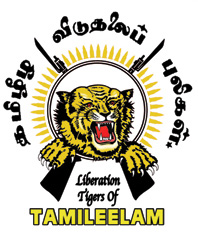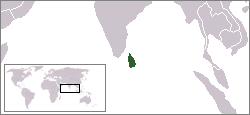
The Liberation Tigers of Tamil Eelam was a Tamil militant organization, that was based in the northern and eastern Sri Lanka. The LTTE fought to create an independent Tamil state called Tamil Eelam in the northeast of the island in response to violent persecution and discriminatory policies against Sri Lankan Tamils by the Sinhalese-dominated Sri Lankan Government.

The Sri Lankan civil war was a civil war fought in Sri Lanka from 1983 to 2009. Beginning on 23 July 1983, it was an intermittent insurgency against the government by the Liberation Tigers of Tamil Eelam led by Velupillai Prabhakaran. The LTTE fought to create an independent Tamil state called Tamil Eelam in the north-east of the island, due to the continuous discrimination and violent persecution against Sri Lankan Tamils by the Sinhalese-dominated Sri Lanka government.
The Indo-Sri Lanka Peace Accord was an accord signed in Colombo on 29 July 1987, between Indian Prime Minister Rajiv Gandhi and Sri Lankan President J. R. Jayewardene. The accord was expected to resolve the Sri Lankan Civil War by enabling the thirteenth Amendment to the Constitution of Sri Lanka and the Provincial Councils Act of 1987. Under the terms of the agreement, Colombo agreed to a devolution of power to the provinces, the Sri Lankan troops were to be withdrawn to their barracks in the north and the Tamil rebels were to surrender their arms.
Rajani Thiranagama was a Sri Lankan Tamil human rights activist and feminist who was assassinated by LTTE cadres after she had criticised them for their atrocities. At the time of her assassination, she was the head of the Department of Anatomy at the University of Jaffna and an active member of University Teachers for Human Rights, Jaffna, and was one of its founding members.

Indian Peace Keeping Force (IPKF) was the Indian military contingent performing a peacekeeping operation in Sri Lanka between 1987 and 1990. It was formed under the mandate of the 1987 Indo-Sri Lankan Accord that aimed to end the Sri Lankan Civil War between Sri Lankan Tamil militant groups such as the Liberation Tigers of Tamil Eelam (LTTE) and the Sri Lankan military.

Shanmugalingam Sivashankar was a Sri Lankan Tamil rebel and leading member of the Liberation Tigers of Tamil Eelam, a separatist Tamil militant organisation in Sri Lanka.
The Jaffna University Helidrop was the first of the operations launched by the Indian Peace Keeping Forces (IPKF) aimed at disarming the Liberation Tigers of Tamil Eelam (LTTE) by force and capturing the city of Jaffna, Sri Lanka, in the opening stages of Operation Pawan during the Indian intervention in the Sri Lankan Civil War. Mounted on the midnight of 12 October 1987, the operation was planned as a fast heliborne assault involving Mi-8's of the No.109 Helicopter Unit, the 10th Para Commandos and a contingent of the 13th Sikh Light Infantry. The aim of the operation was to capture the LTTE leadership at Jaffna University building which served as the Tactical Headquarters of the LTTE, which was expected to shorten Operation Pawan, the battle for Jaffna. However, the operation ended disastrously, failing to capture its objectives due to intelligence and planning failures. The heli-dropped force suffered significant casualties, with nearly the entire Sikh LI detachment of twenty-nine troops, along with six Para commandos, killed in action.
Suppayya Paramu Thamilselvan, commonly known as S. P. Tamilselvan,, was the leader of the political wing of the Liberation Tigers of Tamil Eelam, an organisation fighting for a separate state for the ethnic Tamil minority in the north and east of Sri Lanka from majority Sinhalese government. He was a prominent negotiator and one of the closest associates of LTTE leader Velupillai Prabhakaran.
Operation Pawan was the code name assigned to the operation by the Indian Peace Keeping Force (IPKF) to take control of Jaffna from the Liberation Tigers of Tamil Eelam (LTTE), better known as the Tamil Tigers, in late 1987 to enforce the disarmament of the LTTE as a part of the Indo-Sri Lanka Accord. In brutal fighting lasting about three weeks, the IPKF took control of the Jaffna Peninsula from the LTTE, something that the Sri Lankan Army had tried but failed to do. Supported by Indian Army tanks, helicopter gunships and heavy artillery, the IPKF routed the LTTE at the cost of 214 soldiers and officers.

India–Sri Lanka relations, Indian-Sri Lankan relations, or Indo-Sri Lanka relations, are the bilateral relations between India and Sri Lanka. India has emerged as the foremost partner for Sri Lanka in the endeavor to revitalize its economy, reform its bureaucracy, and enhance decision-making processes for future economic collaborations. India and Sri Lanka share a maritime border. India is the only neighbour of Sri Lanka, separated by the Palk Strait; both states occupy a strategic position in South Asia and have sought to build a common security umbrella in the Indian Ocean. Both India and Sri Lanka are republics that are members of the Commonwealth of Nations.

The Jaffna hospital massacre occurred on October 21 and 22, 1987, during the Sri Lankan Civil War, when troops of the Indian Peace Keeping Force entered the premises of the Jaffna Teaching Hospital in Jaffna, Sri Lanka, an island nation in South Asia, and killed between 60 and 70 patients and staff. The rebel Liberation Tigers of Tamil Eelam, the government of Sri Lanka, and independent observers such as the University Teachers for Human Rights and others have called it a massacre of civilians.

The 1989 Valvettiturai massacre occurred on 2 and 3 August 1989 in the small coastal town of Valvettiturai, on the Jaffna Peninsula in Sri Lanka. Sixty-four Sri Lankan Tamil civilians were killed by soldiers of the Indian Peace Keeping Force. The massacre followed an attack on the soldiers by rebel Liberation Tigers of Tamil Eelam cadres. The rebel attack had left six Indian soldiers, including an officer, dead, and another 10 injured. Indian authorities claimed that the civilians were caught in crossfire. Journalists such as Rita Sebastian of the Indian Express, David Husego of the Financial Times and local human rights groups such as the University Teachers for Human Rights have reported quoting eyewitness accounts that it was a massacre of civilians. George Fernandes, who later served as defense minister of India (1998–2004), called the massacre India’s My Lai.
On 5 October 1987, 12 Tamil Tigers who were taken into custody by the Sri Lankan Navy died by suicide. They were brought by the Sri Lankan Army to the Palaly Military Base which was under Indian Peace Keeping Force control and detained along with 5 others. along with along with The Sri Lankan Navy on the intervening 3 and 4 October 1987 night in the seas near Point Pedro intercepted a LTTE boat coming from Tamil Nadu which has 17 LTTE cadres including Senior leaders Kumarappa the LTTE Area Commander for Batticaloa LTTE and Pulendran the LTTE area commander for Trincomalee.The LTTE cadres offered no resistance and surrendered as they thought they were covered under an amnesty under the Indo-Sri Lanka Accord.LTTE were transferring documents and wherever arms were on board was for the personal protection of the cadres.Sri Lankan government claimed they were carrying weapons. The Sri Lankan Government further wanted them to be tried in Colombo. LTTE leaders including Mahattaya were allowed to visit them in the Palaly Military Base they smuggled in cyanide capsules and as they feared the cadres would be tortured if taken to Colombo .LTTE wanted the IPKF to get them released under the accord. Major General Harkirat Singh J.N.Dixit ,Depinder Singh were against handing over LTTE cadres to the Sri Lankan army but due to orders from New Delhi they agreed. When Sri Lankan Army attempted to take them to Colombo for interrogation, 12 committed suicide by swallowing cyanide capsules and remaining 4 were saved in hospital. This led to the LTTE withdrawing from the Indo Lankan peace accord and conflict between the LTTE and IPKF starting.Harkirat Singh blames the diplomats and the Army headquarters for the turn of events leading to the conflict.
War crimes during the final stages of the Sri Lankan civil war are war crimes and crimes against humanity which the Sri Lanka Armed Forces and the Liberation Tigers of Tamil Eelam have been accused of committing during the final months of the Sri Lankan civil war in 2009. The war crimes include attacks on civilians and civilian buildings by both sides; executions of combatants and prisoners by both sides; enforced disappearances by the Sri Lankan military and paramilitary groups backed by them; sexual violence by the Sri Lankan military; the systematic denial of food, medicine, and clean water by the government to civilians trapped in the war zone; child recruitment, hostage taking, use of military equipment in the proximity of civilians and use of forced labor by the Tamil Tigers.
The Indian intervention in the Sri Lankan civil war was the deployment of the Indian Peace Keeping Force in Sri Lanka intended to perform a peacekeeping role. The deployment followed the Indo-Sri Lankan Accord between India and Sri Lanka of 1987 which was intended to end the Sri Lankan civil war between separatist Sri Lankan Tamil nationalists, principally the Liberation Tigers of Tamil Eelam (LTTE), and the Sri Lankan Military.
A mass murder of police officers took place on 11 June 1990. Members of the Liberation Tigers of Tamil Eelam (LTTE), a militant organization, are alleged to have killed over 600 unarmed Sri Lanka Police officers in Eastern Province, Sri Lanka. Some accounts have estimated the number killed as high as 774.
With the Sri Lankan Civil War spanning for nearly 30 years (1983–2009), the conflict has been portrayed in a variety of ways in popular culture, both during the war and after its conclusion.

The 1987 Eastern Province massacres were a series of massacres of the Sinhalese population in the Eastern Province of Sri Lanka by Tamil mobs and Liberation Tigers of Tamil Eelam (LTTE) during the Sri Lankan Civil War. Though they began spontaneously, they became more organized, with the LTTE leading the violence. Over 200 Sinhalese were killed by mob and militant violence, and over 20,000 fled the Eastern Province. The violence has been described as having had the appearance of a pogrom, with the objective of removing Sinhalese from the Eastern Province.
Sexual violence against Tamils in Sri Lanka has occurred repeatedly during the island's long ethnic conflict. The first instances of rape of Tamil women by Sinhalese mobs were documented during the 1958 anti-Tamil pogrom. This continued in the 1960s with the deployment of the Sri Lankan Army in Jaffna, who were reported to have molested and occasionally raped Tamil women.
Vithusha also spelt as Vidusha commonly known by the nom de guerre Brigadier Vithusha was a Sri Lankan Tamil rebel and member of the Liberation Tigers of Tamil Eelam (LTTE), a separatist Tamil militant organisation in Sri Lanka. She joined the LTTE after being deeply affected by the massacre of Tamils in the Kumudini boat massacre in 1985. She came from a Tamil Brahmin family, her brother Vithushan died in combat during battle with the Sri Lankan Army in Vilakkuvaithakulam in Vavuniya District in 1999. She received her training near Kilili as part of the Freedom Birds training program. She was in charge of stores during the IPKF operations. She got into combat and fought in an attack on the Jaffna Fort and she played a significant role in every military operation in which the women's brigade was involved. She was killed in combat in the Battle of Puthukkudiyirippu in 2009.







